German F1 is a hybrid bred by Dutch breeders by crossing several varieties of cucumbers. It was included in the state registry of the Russian Federation in 2001. The plant is unpretentious and can successfully grow in greenhouses, greenhouses, open ground. Based on the characteristics and description, it can be understood that it does not need pollination. This makes it easier to care for him. Despite the fact that Herman was bred for a long time, he is still chosen by both experienced farmers and amateur summer residents. Photos of the crop grown personally and positive reviews only confirm this.
Content
general characteristics
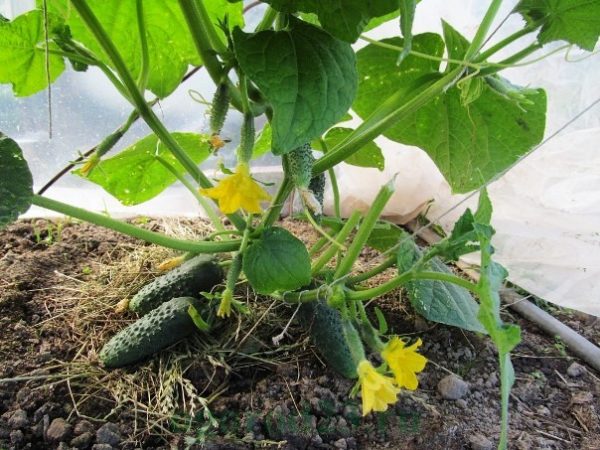
Herman F1 is an early ripening variety. The length of the plant is medium. Its stems are rough, creeping. When grown on a trellis, their length can reach up to 5 m. The leaves are medium-sized, five-lobed, matte, dark green in color. Their edges are nerve, serrate. The flowers are rich yellow, exclusively female. The length of the vegetable itself is 10-12 cm, its diameter is 3 cm, and its weight is about 90 g. If the crop is not harvested for a long time, the length of the cucumber can reach 15 cm.
The vegetable is cylindrical, moderately tuberous, has an average ribbing. Its color can be either light green or dark green. It depends on the degree of illumination of the area where the crop grows. Normally, it should be bright green. The thorns on the cucumbers are light. The taste is pleasant, a sweet aftertaste is characteristic. The appearance of bitterness is unlikely even if the watering is insufficient. The pulp is light green, has an average density. Vegetable can be stored for a long time and not yellow. It can be transported over long distances and not be afraid of damage.
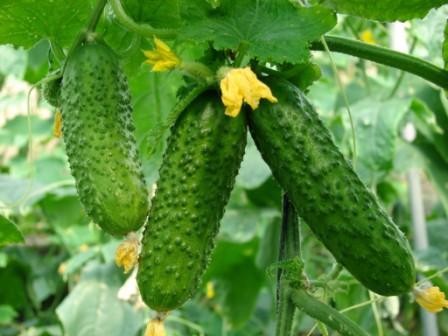 You may be interested in:
You may be interested in:The ripeness of the fruit occurs after 36-40 days, after planting in open soil. Mass harvesting is usually done after 42 days. Productivity of German F1 is high. If it is properly looked after, it can reach up to 25 kg per 1 sq. Km. m. Commodity products in this case is 95%. The use of cucumbers is universal. They can be consumed raw, added to salads or canned.
Growing
Cucumbers can be grown both by sowing and seedling methods. It should be borne in mind that seedlings can hardly tolerate transplants and this can lead to the death of some of the young plants. You can plant seeds in a greenhouse in late April and early May. Planting seedlings is best done in the middle of the month. However, these terms are arbitrary and may vary depending on climatic and weather conditions. In any case, the temperature of the soil should not be lower than 15 ° C.It is recommended to prepare seedlings 4 weeks before the planned transplantation into the ground. Seeds are best planted in special containers or peat tablets. During the growing of seedlings, she needs to provide regular watering and good lighting. Before planting seedlings, it must be tempered for a week. To do this, boxes with it must be taken out into the street. So the plant will be able to get used to environmental conditions and subsequently will be less sick.However, you can not put it in the sun or drafts. The beds for planting need to be prepared in advance. The earth must be carefully dug up and, if necessary, humus or complex mineral fertilizers added to it. Transplant seedlings to the wells.
Similarly, you can sow the seeds immediately into the ground. They need to be brought into the earth to a depth of 15-20 mm through a distance of not less than 25 cm. It is impossible to say for sure how quickly they begin to sprout. Experts assure that these terms depend on the quality of the soil. In fertile land, the first seedlings may appear a week after planting. In dry, they stop growing, and in excessively wet they rot.
Seeds collected from the harvest are not suitable for planting. They need to be bought at the store every time. Purchased seeds are covered with a special shell that contains the substances necessary for the growth and development of the plant. Therefore, they usually have a bright, not characteristic of seeds coloring. Before disembarking, any manipulations with them are not necessary.
Further care and harvesting
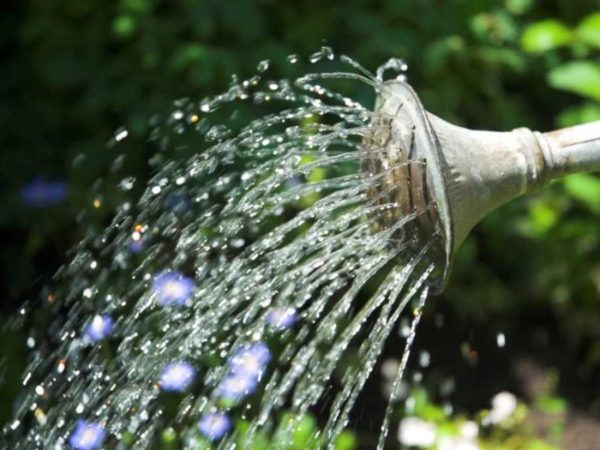
Watering the plant is recommended every 2-3 days. It is better to do this either immediately after sunrise, or shortly before sunset. The irrigation scheme can be adjusted depending on the weather. It is important to prevent excessive waterlogging or drying out. Both extremes can lead not only to lower yields, but also to plant death. Most often, watering the beds should be during the period of heat and drought, as well as during the active formation and growth of fruits.
When growing cucumbers, you can use nitrogen, phosphorus and potash fertilizers. The first agitation should be carried out before flowering begins. During this period, use nitrogen. It is necessary for the rapid growth of stems and leaves. The second time fertilizer is applied when the fruits are actively formed. In this case, phosphorus and potassium are used. These substances are necessary for the formation and growth of fruits. After the first harvest, fertilizer is not necessary.
Shaping cucumber bushes is not difficult. Mustache must be removed in a timely manner, as they take away nutrients. To make the bushes strong, it is recommended to remove all shoots and ovaries from the sinuses of the first four leaves. In the following two sinuses, one ovary should be left, and the rest should be clipped. In the sinuses of 7-10 leaves, you need to remove all the shoots and leave 2 ovaries. On this formation can be considered completed. Pinching the top of the bush and using fertilizer will increase productivity by at least 30%.
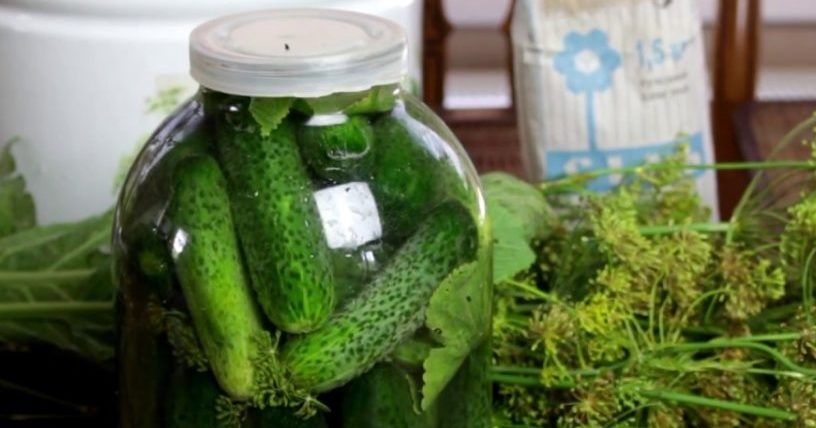 You may be interested in:
You may be interested in:At the end of summer, the productivity of cucumbers decreases. If you take measures during this period, you can extend the fruiting and get a second wave of harvest. For this, it is better to use foliar hemming. It is necessary to mix 1 liter of whey or milk with 35 drops of iodine and spray the leaves with this product. You can also pour 10 g of boric acid in 1 liter of water heated to 90 ° C, and then add another 9 liters of water to the product. This solution is no less effective. In any case, the processing of the plant should be performed in the evening in clear weather.
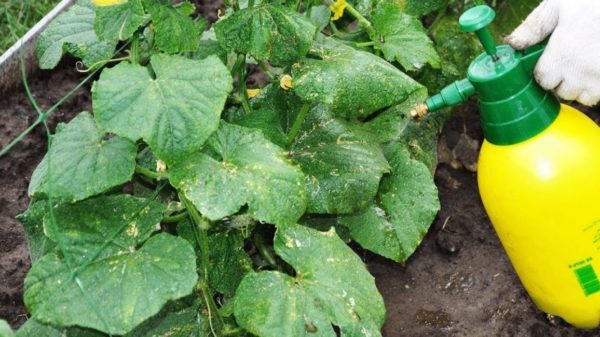
Harvest need 1 time in 2 days. For clogging, it is better to choose cucumbers 5-7 cm long, and for salads - 10-1 cm. The more often the summer resident collects the crop, the faster new cucumbers will form, and the longer the plant will bear fruit. Fresh vegetables should be stored in the refrigerator. Shelf life is a week. Harvesting is preferably done in the morning or evening. Beam type cucumbers should be cut with scissors.
Disease resistance, advantages and disadvantages
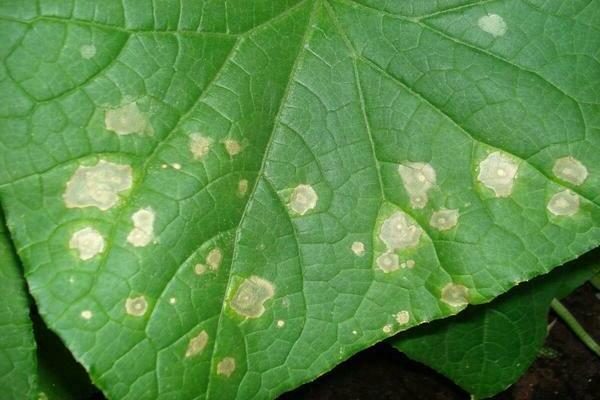
Herman F1, like most hybrids, is more resistant to disease than ordinary varietal plants. He is not afraid of powdery mildew, cladosporiosis, and cucumber mosaics, but he is defenseless against fungal diseases. The problem arises after irrigation with cold water or due to adverse weather, when the difference between the air temperature day and night is too large.
A characteristic symptom of the active reproduction of fungi is the appearance on the leaves of large spots of rusty color. Often, the disease occurs at the seedling stage. In this case, brown spots appear on the root neck. If treatment is not started on time, young plants will die within a few days. A solution of arceride or Bordeaux fluid will help eliminate the disease. In the first case, the plant needs to be processed once, and in the second - periodically throughout the entire growing season. If the fungus is affected by the root neck, it must be sprinkled with soil. This is necessary in order to form new roots.
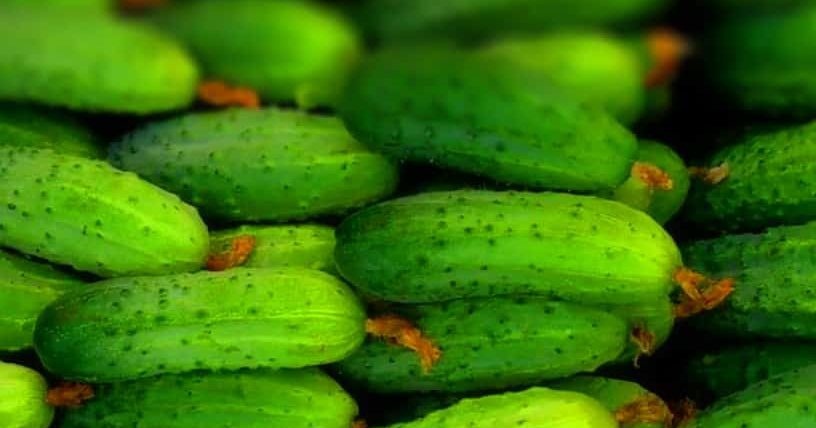 You may be interested in:
You may be interested in:In general, agronomists distinguish such advantages of this variety:
- early ripening;
- self-pollination;
- high productivity;
- a large percentage of marketable products;
- the ability to use a vegetable for cooking different dishes;
- high phytoimmunity;
- the possibility of growing, both in open ground and in greenhouses.
However, the variety is not without flaws. Some include the average density of the pulp of the fetus. Therefore, lovers of "crunch" is better to choose other cucumbers. Among other cons:
- predisposition to fungal diseases;
- poor survival of seedlings;
- sensitivity to temperature extremes;
- sensitivity to soil temperature (if it is cold, the plant may die).
Reviews
Alexandra, 38 years old
I have been growing German F1 for the fifth year and I am completely satisfied with it. He has a pleasant, sweet taste. Cucumbers are small, the seeds in them are also small. Perfect for salting. Two years ago I bought a drip irrigation system, from which the already high yield increased even more. There are so many vegetables on the bushes that I do not have time to collect them. Moreover, there is no void inside, and bitterness is also absent.
David, 32 years old
I have been growing German F1 cucumbers for the seventh year and they have always pleased. I tried to plant with seeds and through seedlings - everything always worked out. Bushes are strong, grow quickly. I noticed that the plant loves organic matter, so every year I add manure and peat to the ground. Due to this, as a result, I get a plentiful and tasty crop, although the soil itself at the summer cottage is heavy and depleted.
German F1 is an excellent choice for any summer resident, no matter what experience with plants he has. Reviews of farmers who have cultivated this variety prove that it has advantages that cover any disadvantages. Timely planting and proper care will allow you to prepare a lot of blanks for the winter and provide the whole family with tasty, healthy vegetables.




 Armenian cucumber with melon flavor: description and characteristics, reviews
Armenian cucumber with melon flavor: description and characteristics, reviews Do-it-yourself vertical beds for cucumbers: schemes, photos
Do-it-yourself vertical beds for cucumbers: schemes, photos Hollow cucumbers: reasons for the appearance of hollow, what to do
Hollow cucumbers: reasons for the appearance of hollow, what to do Which manure is best for cucumbers: application, how to breed
Which manure is best for cucumbers: application, how to breed
Mara
Not a fountain. Long away. And something is doubtful in the pickle.
Much worse Restina from Biotechnology. These and with "frosts" bear fruit. And do not fall out.And in this cold summer only on Restin and leave.
Gentlemen, try Restina, that's really a really gorgeous cucumber.